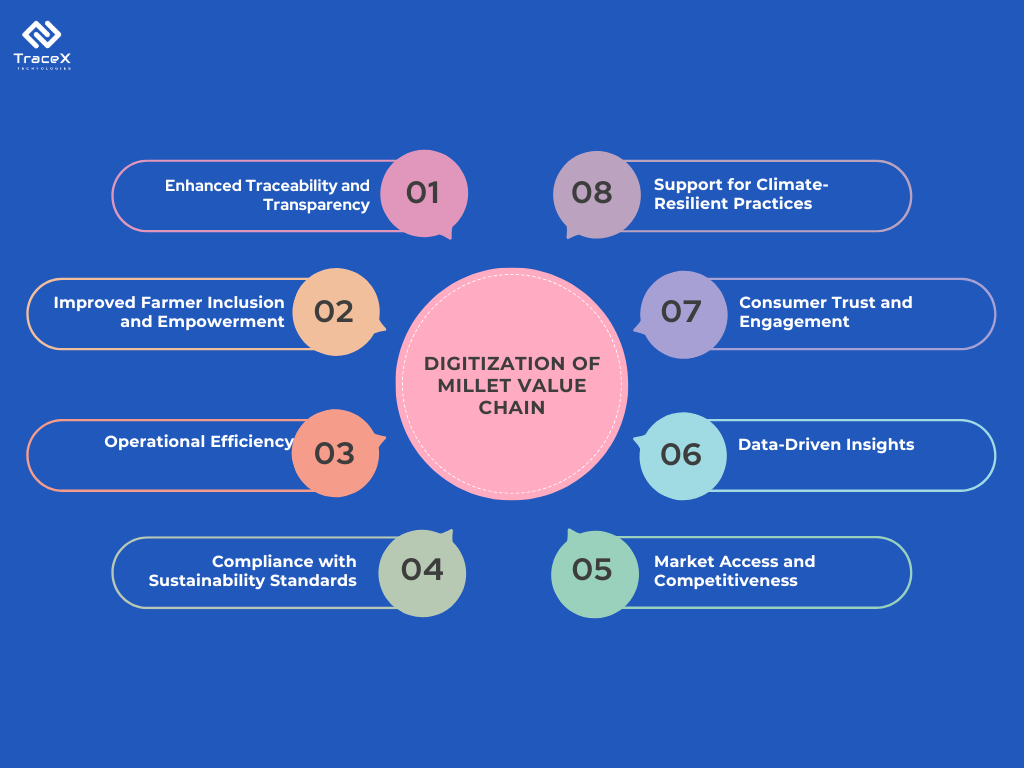Contact: +91 99725 24322 |
Menu
Menu
Quick summary: Explore how digital solutions and innovative practices are transforming the millet value chain, ensuring transparency, sustainability, and profitability. Learn how these changes benefit farmers, consumers, and the environment.

Millets—often called the “crops of the future”—are stepping into the spotlight to address some of the most pressing challenges in global food security and sustainability. Yet, despite their potential, the millet value chain remains fragmented, plagued by inefficiencies, and unable to fully unlock the benefits these grains can provide.
Millets can play a significant role in enhancing food security and nutrition for India and many other nations worldwide
As climate change intensifies and demand for sustainable food options rises, the transformation of the millet value chain has become not just an opportunity but a necessity. This shift can empower smallholder farmers, meet evolving consumer expectations, and build resilient agricultural ecosystems. In this blog, we’ll explore why modernizing the millet value chain is critical and how innovative solutions are driving this change.
Key Takeaways
The millet value chain encompasses all the stages and stakeholders involved in bringing millet from farm to fork.
The value chain isn’t just about farmers; it’s a network of different players:
The millet value chain has immense potential, but several challenges keep it from being fully efficient or profitable:
Technology is proving to be a game-changer for transforming the millet value chain. It’s helping bridge gaps, empower stakeholders, and make processes smoother, all while boosting efficiency and profitability.
Farmer profiling tools collect and organize detailed data about farmers—think of it as creating a digital profile for every farmer. This includes information about their land, farming practices, crops grown, and more.
Imagine a world where a millet farmer in a remote village can connect with global buyers through a digital network—it’s happening!
Traceability platforms are like the GPS of the millet value chain. They track the journey of millet, from the farm to the final consumer.
For example, if a batch of millet doesn’t meet quality standards, a traceability system can pinpoint exactly where things went wrong—be it at the farm, during transport, or at the processing stage.
Svojas’s Millet Food Traceability Journey with TraceX Solutions
Svojas leverages TraceX’s blockchain-based traceability platform to create a transparent and verifiable millet value chain. This initiative enables them to establish complete traceability of their millet products, documenting every stage from cultivation to processing, distribution, and retail. By integrating sustainable practices and ensuring food safety compliance, Svojas offers consumers an authentic farm-to-fork narrative. This not only reinforces consumer trust but also aligns with global sustainability and quality standards, showcasing their commitment to providing safe, ethical, and eco-friendly millet products.
Supply chain optimization tools use data and advanced analytics to improve the flow of millet across the value chain.
Think of it as a way to ensure that the right amount of millet gets to the right place at the right time, with minimal losses along the way.
When these technologies—farmer profiling, traceability, and supply chain optimization—work hand in hand, the millet value chain becomes stronger, more transparent, and more sustainable. Farmers benefit from better prices, consumers enjoy higher-quality products, and businesses meet their sustainability goals.
It’s not just about making things easier; it’s about creating a system where everyone wins. And with millets being touted as a key to sustainable food systems, technology is paving the way for their rightful place in global agriculture.
Millets are more than just a nutritious food source; they hold the key to building a sustainable agricultural system.
Regenerative agriculture goes beyond sustainability—it works to heal the land. For millet farming, this means adopting methods that improve soil health, increase organic matter, and restore the ecosystem.
The result? Not only do these practices yield healthier crops, but they also make farming more resilient to climate shocks like droughts or erratic rainfall.
Millets come in various types—finger millet, pearl millet, foxtail millet, and more—each suited to different climates and soils. Growing these diverse varieties promotes biodiversity in agriculture.
A millet farm can act as a hub for thriving biodiversity, creating a win-win for the planet and the farmer.
One of the biggest challenges in agriculture is the carbon emissions generated from transportation and processing. Millets offer an opportunity to keep things local.
For example, a local community that grows, processes, and consumes millets ensures that the grain’s journey from farm to plate is shorter and greener.
By combining regenerative farming, biodiversity support, and localized supply chains, the millet value chain can drastically lower its environmental impact while improving livelihoods. Every bowl of millet consumed becomes a step toward healthier ecosystems and empowered farmers.
It’s a vision of sustainability that goes beyond just farming practices—it’s about creating an entire ecosystem where people and the planet thrive together. And millets, humble as they seem, are leading the charge.

The TraceX food traceability platform is a blockchain-powered solution designed to enhance transparency, accountability, and efficiency across the entire food supply chain. It enables businesses to trace their products’ journey from farm to fork, ensuring compliance with food safety, quality, and sustainability standards.

A Research institution at Kerala leverages technology to digitize farm activities, crop activities, harvest activities and bring the power of technology onto their millet farms
TraceX Traceability and Farm Management platform helps the institution to enhance transparency and traceability in the millet supply chain, leveraging blockchain technology. The platform supports crop planning, monitoring, harvest, and post-harvest management, ensuring seamless tracking of the supply chain. By documenting every stage from farm to fork with precise data, it enables efficient activity tracking and supply chain assessments, fostering accountability and sustainability in millet production and processing.
The millet value chain is undergoing a transformative shift towards sustainability, transparency, and efficiency, driven by the adoption of digital solutions and innovative practices. By integrating technology, such as traceability platforms, supply chain optimization tools, and regenerative agricultural methods, the millet industry can enhance farmer profitability, improve market access, and meet the growing consumer demand for ethically produced, sustainable food. This transformation not only ensures food safety but also contributes to the global push for sustainable agriculture, creating a more resilient and responsible food system for future generations.
Traceability platforms allow for the monitoring of millet from farm to fork, ensuring transparency, verifying quality, and complying with sustainability standards. This helps in building consumer trust and enhancing the marketability of millet products.
Regenerative farming practices focus on improving soil health, enhancing biodiversity, and reducing carbon footprints, ensuring that millet farming is more sustainable and aligned with global environmental goals.
Digital platforms provide smallholder farmers with better access to markets, resources, and training. Through solutions like farmer profiling and crop monitoring, these platforms help increase productivity, profitability, and overall sustainability in the millet value chain.
